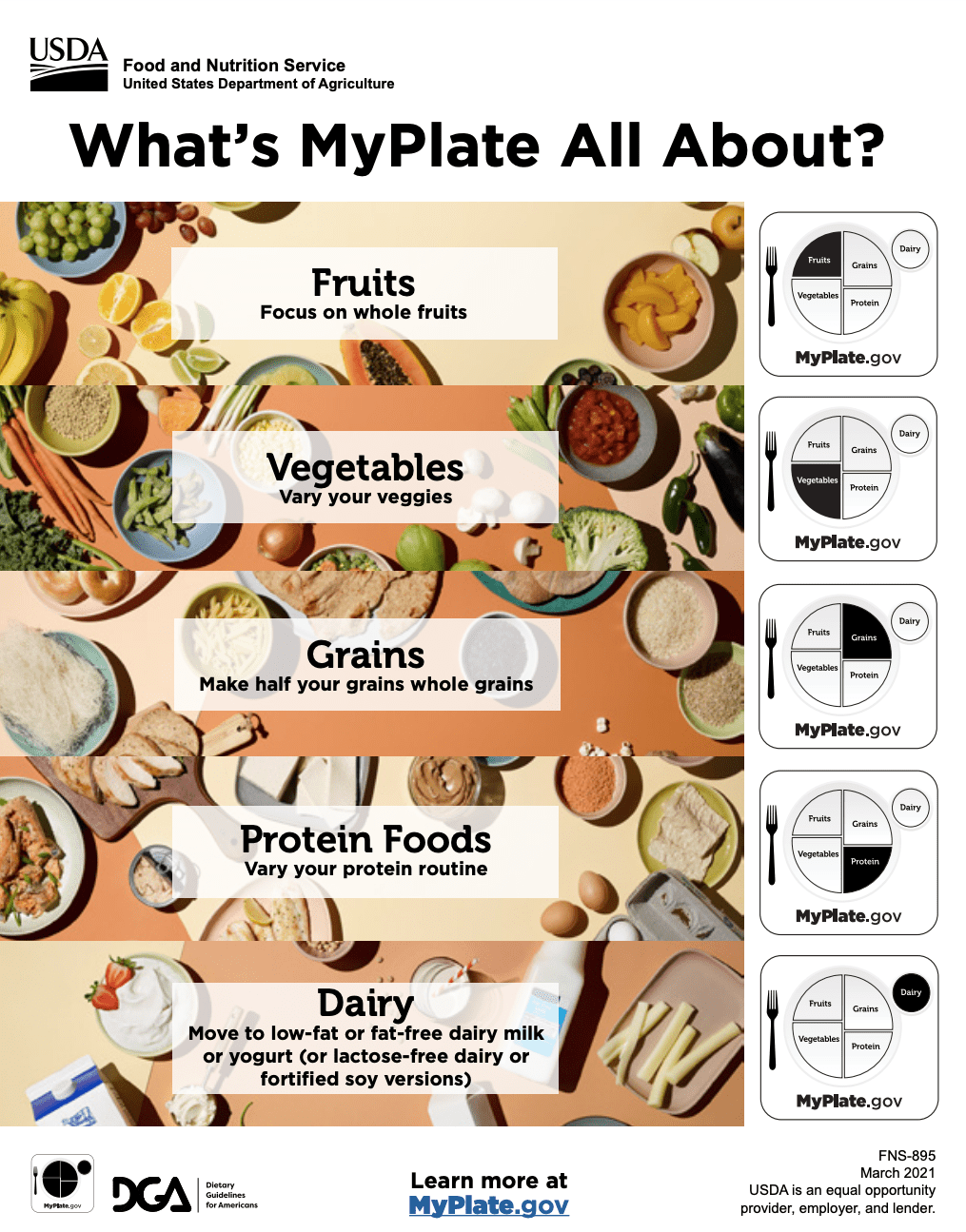
National Nutrition Month is an excellent time to learn about how we can develop better eating habits and healthier lifestyles. Learn more about seniors’ changing nutritional needs, find assistance for low-income adults, and more.
Updated May 19, 2022
March Is National Nutrition Month
Every March, the Academy of Nutrition and Dietitians sponsors National Nutrition Month, an education and awareness campaign to raise awareness of healthy eating and physical activity. People are encouraged to learn about better food choices and develop healthier habits throughout the month.
Why National Nutrition Month Matters To Seniors
National Nutrition Month is the perfect time for older adults to consider the impact certain food choices have on their bodies. Eating well promotes longevity and better quality of life, including your physical, mental, and emotional wellbeing. For example, proper protein consumption reduces muscle loss, while a balanced diet can lower the risk of diabetes, hypertension, heart disease, and other chronic diseases.
For older adults, especially, reassessing your dietary needs is critical. Of course, the effects of poor nutrition are harmful to people of all ages. But for seniors, the consequences can be particularly detrimental because of age-related changes.
An unbalanced diet can cause several serious health concerns, such as:
- Cancer
- Vision loss
- Heart conditions
- Cognitive decline
- Muscle and joint weakness
- Susceptibility to bacterial infections
National Nutrition Month Raises Awareness About Seniors' Nutritional Challenges
Unfortunately, many seniors face several nutritional hurdles that make it challenging to maintain a healthy lifestyle and a balanced diet, such as:
- Aging naturally causes hearing, smell, and taste changes, impacting appetite.
- Inactivity can affect metabolism and make it difficult to adjust caloric intake.
- Losing the ability to cook for themselves, whether due to a physical condition or another reason.
- Minimal or nonexistent access to fresh, whole foods due to transportation or income limitations.
- Dental problems, gastrointestinal discomfort, malaise, and other physical issues that affect appetite and digestion.
Tips For Older Adults' Nutritional Needs
Simple changes can go a long way toward building healthy eating habits. The following tips can help you meet your nutritional needs and lower the risk of chronic conditions or illnesses.
Review The USDA's Updated Food Pyramid
In 2011, former First Lady Michelle Obama and USDA Secretary Tom Vilsack released MyPlate, an updated version of the traditional food pyramid. This simple graphic, pictured right, provides more accurate portion sizes for the five primary food groups based on the USDA’s 2010 Dietary Guidelines.
Limit These Foods
As you think about the best foods for your health, consider limiting the following:
Sodium
Sodium is okay in moderation, but it’s important to watch your intake as it leads to water retention and high blood pressure. The USDA recommends that older adults consume no more than 2,300 milligrams of sodium per day.
Complex Carbohydrates
Carbohydrates are essential for a well-balanced diet, but there’s a difference between “healthy” and “bad” carbs. Healthy carbs include foods like fruits, vegetables, and beans. These have more nutrition than complex carbs like white flour, refined sugar, or white rice.
Not only do complex carbs have fewer nutrients (if any), but they also cause spikes in blood sugar. For example, have you ever eaten a bowl of cereal for breakfast and then felt groggy and snack-ish after a few hours? It’s because of the drop in blood sugar from eating complex carbs.
Sugar
Many studies show a definitive link between excessive sugar intake and tooth decay, weight gain, diabetes, insulin resistance, cardiovascular disease, and other serious long-term conditions. But unfortunately, sugar is unavoidable in the US, even in foods you may not suspect. Bread, canned soups, pasta sauce, frozen dinners, ketchup, cereal, and nearly everything else contain high sugar.
While it’s okay to have some sugar, be aware of how much is in the things you eat. Sugar should account for less than 10% of your daily calorie intake, so check nutrition labels, even for organic products or items typically considered “health foods.”
Focus On Variety
Colorful, vibrant foods are often the best source of nutrients, so try to make meals as colorful as possible.
Eating diverse foods ensures you get all the necessary vitamins and minerals. A balanced meal should have:
- Lean protein (lean meats, seafood, eggs, beans)
- Fruits and vegetables (think orange, red, green, and purple)
- Whole grains (brown rice, whole-wheat pasta)
- Low-fat dairy (milk and its alternatives)
Here are some of the most important nutrients for seniors and easy ways to add them to meals.

Vitamin B12
26% of adults over 60 have a B12 deficiency. B12 deficiency can cause lethargy, weakness, heart palpitations, anemia, and nerve problems. This vitamin, typically found in foods like grass-fed meat, salmon, eggs, and dairy, is essential because it supports vital functions such as red blood cell production and cognition. Vitamin absorption becomes less efficient as we age, so your body may be deficient even if you get enough B12. A supplement can also help you meet your daily requirement.
Potassium
Potassium is one of seven macrominerals, which are the minerals the body needs the most. It’s crucial for many body functions, including heart, cell, skeletal, and muscular functioning. For many adults, some medications can interfere with potassium absorption. A poor diet can also contribute to a deficiency. Supplements can help, but a diet full of potassium-rich foods is your best option. Meat, dairy products, beans, veggies, and fruits are all high in potassium.
Fiber
Fiber is another nutrient crucial for overall wellbeing because it helps digestive regulation and colon and intestinal health. Many older adults deal with irregularity, constipation, or gastrointestinal discomfort. Some medications can worsen these problems or keep the body from absorbing fiber effectively. Men and women need over 20 grams of fiber daily to keep their digestive system running smoothly. Whole fruits and veggies, grains, and black beans are all excellent sources of fiber.
Calcium
Seniors need about 1200 mg of calcium each day to maintain bone health. So while the first inclination is to reach for a glass of milk or a piece of cheese, there are other, healthier options to help you meet this recommendation, such as kale, almonds, and tofu. These particular foods also provide many different nutrients and contain less fat than dairy products.

Stay Hydrated
Older adults are more at risk for dehydration because their sense of thirst may decline with age. Seniors who live in arid climates are particularly at risk of dehydration, which can cause UTIs, constipation, confusion, and other serious problems.
Coffee and tea can cause dehydration, so limit consumption to a few cups per day. Try freezing grapes for a hydrating snack or infusing fruit and water for a refreshing beverage.
Quit Smoking
You’re never too old to stop smoking. In addition to being incredibly detrimental to you physically, smoking also suppresses your appetite, dulls your sense of taste, worsens existing health problems, and makes food less enjoyable.
Consider Meal Delivery
Meal delivery services support independence for older adults, those with limited mobility, or lack adequate transportation. Many Medicaid plans offer meal delivery benefits, making these services more accessible for low- to mid-income seniors. Some popular meal delivery services include:
- Silver Cuisine by BistroMD
- Meals On Wheels America
- HelloFresh
- Magic Kitchen
- Mom’s Meals
Plus, you can also order groceries straight to your door through Instacart. Additionally, large grocery chains have pickup locations where employees will load your order straight to your vehicle.
Probiotics
Like fiber, probiotics support digestion and general gut health. According to Harvard Health, a growing number of digestive disease experts recommend probiotic supplements to ease irritable bowel syndrome and other gut issues. However, food and drug agencies have yet to test and approve probiotic supplements, so consider discussing the best options with your doctor.
Shopping & Planning Tips For Seniors & Caregivers
- Make a list. Make a list of healthy foods you want to eat throughout the week. Planning saves time and money.
- Bring a friend. The company makes grocery shopping more accessible and enjoyable.
- Be diverse. It’s easy to eat the same thing every week, so don’t be afraid to try something new.
- Shop the border. The best foods for you are whole foods found on the edge of the grocery store. Think meats, produce, and dairy. But if you do eat packaged foods, become an informed consumer and read the label to make more health-conscious selections.
- Avoid convenience foods. It’s tempting to buy things that don’t take much time to prepare, but these foods don’t have what older adults need.
- Clip coupons. At home, look for special promotions, offers, and discounts from the shops you visit the most.

- Discount programs. Sign up for store discount cards to receive special deals and discounts.
- Try off-brands. Store-brand items are more affordable and the same as name-brand products.
- Make a sensible budget. Remind yourself to be smart about your spending. For example, the price of chips and cookies can buy healthy options like apples, bananas, carrots, and more.
- Find hydrating choices. Water isn’t the only way to stay hydrated. Look for things like watermelon, popsicles, and other hydrating fruits. You can also find something to flavor regular water, such as lemons and limes to water.
Nutrition Resources On A Budget
Fixed or limited incomes can limit seniors’ ability to buy healthy, nutritious food. The USDA offers several food and nutrition services to help meet this need. Qualifying seniors can receive federal assistance through one or more of the following programs:
Federal Nutrition Assistance Programs For Seniors
MyPlate Shop Simple Tool
The MyPlate Shop Simple tool locates local discounts and deals to help people find affordable foods within their budget.
Supplemental Nutrition Assistance Program (SNAP)
SNAP benefits help needy families’ budgets go further with supplemental nutrition benefits. More than 4 million seniors use SNAP, with the average recipient receiving $113 per month. Visit the Supplemental Nutrition Assistance Program page to check your eligibility and learn more.
Child & Adult Care Food Program (CACFP)
CACFP provides reimbursements for healthy foods to qualifying children and adults receiving care at participating child or adult day care centers or care homes. Visit the Child and Adult Care Food Program page to see if you qualify.
Senior Farmers' Market Nutrition Program (SFMNP)
SFMNP is a unique program that supports both seniors’ nutritional needs and local agriculture commodities. By helping low-income older adults access local produce and other foods, SFMNP promotes the development of new and existing farmers’ markets, roadside stands, and community-backed agricultural programs. For more information, visit the Senior Farmers’ Market Nutrition Program page.
Commodity Supplemental Food Program (CSFP)
CSFP delivers USDA Foods to low-income seniors. Additionally, the USDA offers food and administrative funding to participating states and Indian Tribal Organizations. Visit the Commodity Supplemental Food Program page to see if this program is available in your state.
Resources For Military & Veteran Families
The USDA offers nutrition assistance for veterans and their families. Visit the Military and Veteran Families resource page to learn about programs and eligibility.
MeetCaregivers Supports National Nutrition Month
National Nutrition Month is an excellent time to learn about how we can develop better eating habits and healthier lifestyles.
Family caregivers can’t always guarantee that their loved ones get the nutrition they need. But, if you’re concerned about your loved one’s health, a professional caregiver could help. Whether you need a respite break or a few hours of extra support during the week, we can help — Call 1-888-541-1136 or email info@meetcaregivers.com to talk to one of our care coordinators.
Visit the Blog for additional resources for caregivers, seniors, and families.
- Care, Home Instead Senior. “National Nutrition Month: Seniors Encouraged to Focus on Healthy Eating.” P.R. Newswire: Press Release Distribution, Targeting, Monitoring, and Marketing, June 26, 2018, www.prnewswire.com/news-releases/national-nutrition-month-seniors-encouraged-to-focus-on-healthy-eating-300422787.html.
- eatright.org. (n.d.). National Nutrition Month. EatRightPro.org. Retrieved May 18, 2022, from https://www.eatrightpro.org/media/press-releases/national-nutrition-month
- “National Nutrition Month.” Senior Living, 15 Feb. 2018, www.seniorlivingsystems.org/national-nutrition-month/.
- Fairbanks, J. (2021, February 8). 6 Ways Poor Nutrition Affects Older Adults. HomeCareAssistanceCedarValley.com. Retrieved May 18, 2022, from https://www.homecareassistancecedarvalley.com/impact-of-inadequate-nutrition-on-seniors/
- Healthline Media U.K. Ltd, Brighton, UK, a Red Ventures Company. (n.d.). What Is The Impact Of Eating Too Much Sugar? MedicalNewsToday.com. Retrieved May 18, 2022, from https://www.medicalnewstoday.com/articles/eating-too-much-sugar#long-term-risks Last medically reviewed on June 30, 2020
- “National Nutrition Month: Most Important Nutrients for Seniors.” Senior Care, Assisted Living, Homecare, and Rehabilitation at Woodlands, www.woodlandsllc.com/national-nutrition-month-most-important-nutrients-for-seniors.
- Producer, Morning Show. WBFF, WBFF, 16 Mar. 2019, foxbaltimore.com/morning/national-nutrition-month-senior-citizens.
- “Senior Nutrition – Healthy Eating Tips & Resources.” NCOA, 16 Aug. 2017, www.ncoa.org/economic-security/benefits/food-and-nutrition/senior-nutrition/.
- The President and Fellows of Harvard College. (2020, April 13). Health Benefits of Taking Probiotics. Health.Harvard.edu. Retrieved May 18, 2022, from https://www.health.harvard.edu/vitamins-and-supplements/health-benefits-of-taking-probiotics
- U.S. Department of Agriculture and U.S. Department of
Health and Human Services. Dietary Guidelines for Americans, 2020-2025.
9th Edition. December 2020. Available at DietaryGuidelines.gov. - Woodard, Regina. “Celebrating National Nutrition Month by Asking – What’s A Senior To Eat?” Facilities, 2012, www.assisted-living-directory.com/content/nutrition-month.cfm.

